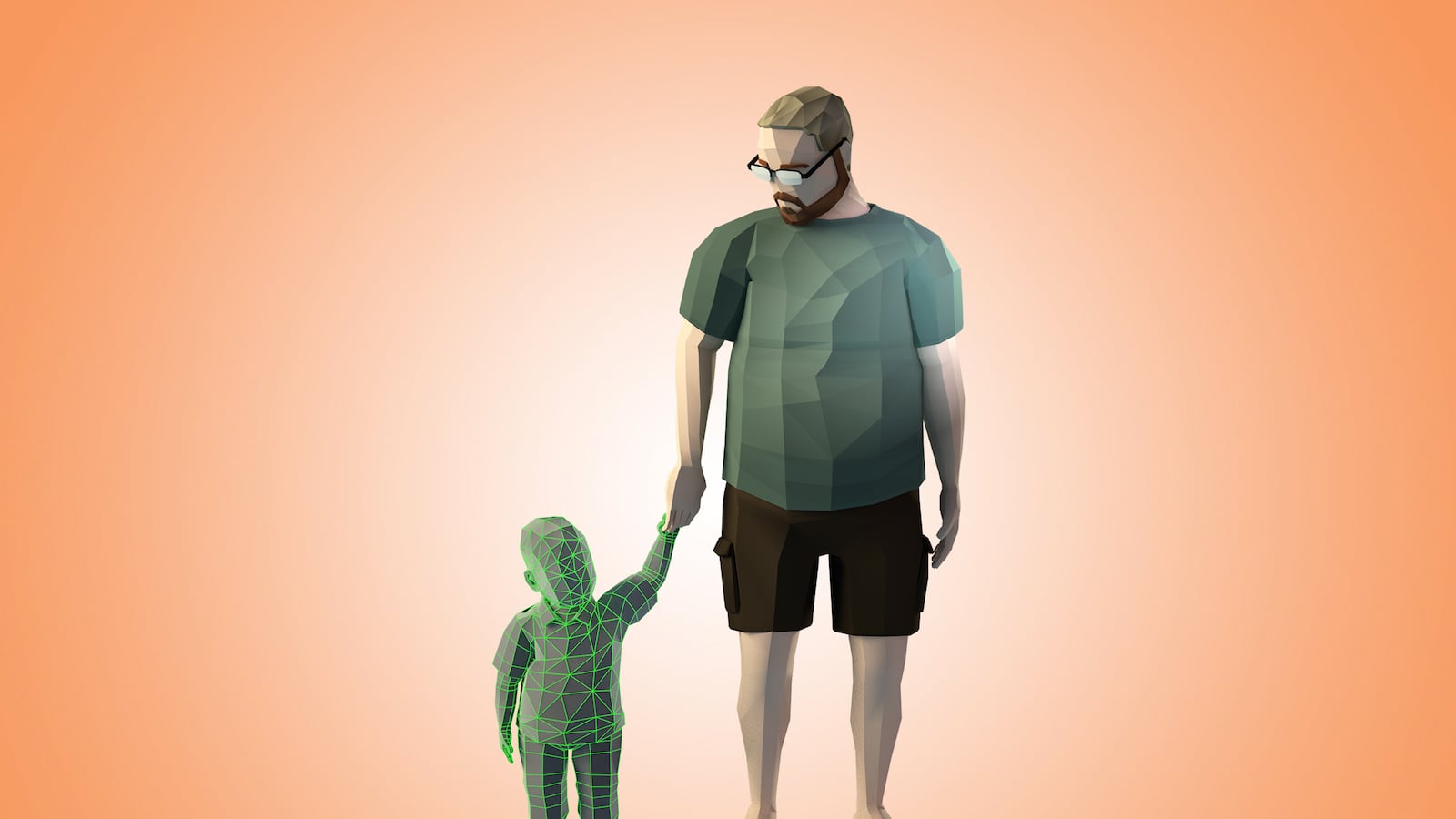A door opens onto a digital office, where a polygonal couple sits on couches opposite similarly geometrically conceived doctors. They’re informed by these physicians that their son’s cancer has returned—meaning his chemo treatment has failed—and that their facility is very good at providing “end-of-life care” for people in his circumstances. The camera cuts to the father, his face turned downward, and soon the room is engulfed in rain, creating pools of water that rise, rise, rise until the man is suddenly in a rowboat with his sick son, who sits silently alongside him while wearing a life vest. As the man weathers this storm, the phrase “end-of-life” reverberates through the downpour.
That encounter is the opening scene of the new documentary Thank You For Playing, as well as an early level in a videogame called That Dragon, Cancer created by the film’s subject, Ryan Green, a Colorado designer driven to develop the title as a means of comprehending, coping with, and grieving over his young son Joel’s terminal brain cancer (which was diagnosed when the tyke was a one-year old, and was supposed to kill him in mere months). For Ryan, That Dragon, Cancer is an expression of his misery and fears, and also a way for him to connect with others—and, in doing so, to mitigate the crushing loneliness and spiritual terror that his son’s condition has wrought. It’s an experiential title, one that places players in Ryan’s (and his wife Amy’s) shoes as they manage Joel crying uncontrollably at night, suffering through feeding-tube meals, and enjoying all-too-brief respites of joy.
In other words—and with all due respect to the late Roger Ebert, who famously claimed that games were incapable of achieving this designation—That Dragon, Cancer is art, made by an artist grappling with his sorrow, his anxiety, his dread, his faith and his (and his son’s) mortality. Utilizing a medium that demands interaction, it’s a work of expressive communication, marked by avatars that have been designed to resemble their real-life counterparts (replete with their own voices), and yet just abstract enough—they have no eyes, and their facial expressions are minimal—to allow players to fully “enter” this highly personal space. It’s akin to reading a series of intimate, dramatized diary entries about a family’s ongoing tragedy. And just as playing it proves to be a heartrending experience for those who give it a try during a video game convention (their tears speaking volumes about its power), so too is Thank You For Playing a wrenching document of striving to creatively wrestle with anguish.
Assuming up-close-and-personal proximity to their subjects over the course of the game’s creation, which coincides with Joel’s deterioration due to newly developing tumors, directors David Osit and Malika Zouhali-Worrall’s film straddles the same fine line between confession and exploitation as That Dragon, Cancer. It’s a tight-rope act that Ryan sporadically discusses, as when he and Amy debate whether or not to use Joel’s actual crying as a sound effect (especially in light of their decision to include the boy’s laughter). Aside from a scene in which Ryan reads an Internet commenter’s censure of the project as worthlessly manipulative, Thank You For Playing doesn’t directly address the question of whether Ryan’s game serves a legitimate artistic function. However, the role of art—is it enough to merely articulate personal emotions? Or should it also convey something enlightening, or profound, about its given subject?—is nonetheless the larger issue hovering over the film.
Further underscoring its uniqueness is that, unlike the legions of ultra-violent bloodbaths currently crowding the gaming marketplace—as shrewdly evidenced by clips from a convention’s most popular offerings—That Dragon, Cancer is a game about real-world death, the sort that can’t be staved off through health packs, or reversed through magic spells or “continue” features. As Ryan says during a convention panel, it’s a game designed to be the opposite of “escapism;” its purpose is to unite people by allowing them to see, feel and understand someone else’s life. Moreover, as he later confesses, it’s also a game motivated by his need to hold onto the memory of his son—and, furthermore, to attempt to know the boy, whose tumor has left him, even at age four, the mental equivalent of an infant, incapable of speaking or developing a mature personality.
Thank You For Playing’s most poignant passages involve everyday snapshots of Ryan giving Joel stomach raspberries, or cradling him as he endures yet another tube being inserted into his nose or his torso. Those moments, like Ryan’s Facetiming sessions with his fellow programmers, and his and Amy’s conversations about the game (and their life), capture a warts-and-all sense of average Americans struggling to make sense of death, and the logistical and spiritual ramifications of its unexpected arrival. Though little overt mention is made of their piousness, Ryan and Amy are shown to be religious Christians, adding an extra dimension to their unhappiness, as they endeavor to reconcile their faith with the senselessness of their son’s illness, as well as reassess—in the face of Joel’s pain, and inevitable demise—their belief in the afterlife.
Such thoughts and doubts are left unresolved in Thank You For Playing, just as they are in That Dragon, Cancer (and in life). Rather than wrapping things up in some disingenuously neat and tidy manner, Osit and Zouhali-Worrall remain true to the essence of death as a horror that the living are not only forced to endure, but to invariably move past—a notion conveyed in dueling images of a digital Joel standing along on a diagrammatic black-and-white grid, followed by the sight of Ryan, Amy and their other kids’ avatars in that same location, staring off into an endless black horizon. As Joel prepares to depart, the Greens are blessed with another child, creating a birth/death juxtaposition that speaks to Amy’s opinion that, even amidst unthinkable sadness, happiness is still capable of flourishing. In that final, gracefully handled note, the film again proves itself a mature meditation on the ordeal of tragedy, and art’s capacity for helping us process it.






